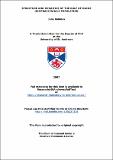Files in this item
Structure and dynamics of the Gulf of Maine humpback whale population
Item metadata
| dc.contributor.advisor | Hammond, Philip S. | |
| dc.contributor.author | Robbins, J. | |
| dc.coverage.spatial | x, 168 p. | en |
| dc.date.accessioned | 2007-05-07T09:04:33Z | |
| dc.date.available | 2007-05-07T09:04:33Z | |
| dc.date.issued | 2007-06 | |
| dc.identifier | uk.bl.ethos.551980 | |
| dc.identifier.uri | https://hdl.handle.net/10023/328 | |
| dc.description.abstract | Population structure and vital rates of Gulf of Maine (GOM) humpback whales, Megaptera novaeangliae, were studied by a combination of longitudinal data, region-wide surveys and modern mark-recapture statistical methods. Demography and rates of exchange were examined among six GOM areas. Juveniles and females were preferentially encountered in southern GOM habitats, including at the Studds Stellwagen Bank National Marine Sanctuary (SBNMS). Multi-state modelling also revealed unequal probabilities of movement between areas that was not explained by inter-area distance, adjacency, whale density or dominant prey type. Aerial surveys and photo-identification data indicated that the population was likely closed to migration between June and September. Otherwise, seasonal trends in population composition were consistent the demographically staggered migration reported in other oceans. Over-wintering occurred,but there was little evidence that a significant number of humpback whales failed to undertake or complete migration each year. Vital rates varied with sex, age and time. Juveniles exhibited lower and more variable survival than adults and so were a potential source of downward bias in “non-calf” survival estimates. Males exhibited higher survival than females and achieved maximal survival at age five, the estimated age at male puberty. By contrast, females did not reach peak survival until the current average age at first birth (8.78 years, s = 2.33). The latter was significantly higher than previous estimates and females that recruited by age seven had a lower likelihood of subsequent survival than those that recruited late. Costs of reproduction persisted into adulthood, with breeders exhibiting lower survival than nonbreeders. Calves born during years of low fecundity exhibited lower survival than those born when fecundity was high, possibly due to lower maternal investment. Costs of reproduction have not previously been described in cetaceans, but are consistent with the risks potentially associated with capital breeding. | en |
| dc.format.extent | 1779785 bytes | |
| dc.format.mimetype | application/pdf | |
| dc.language.iso | en | en |
| dc.publisher | University of St Andrews | |
| dc.rights | Creative Commons Attribution-NonCommercial-NoDerivs 3.0 Unported | |
| dc.rights.uri | http://creativecommons.org/licenses/by-nc-nd/3.0/ | |
| dc.subject | Humpback whale | en |
| dc.subject | Megaptera novaenangliae | en |
| dc.subject | Gulf of Maine | en |
| dc.subject | North Atlantic | en |
| dc.subject | Reproduction | en |
| dc.subject | Survival | en |
| dc.subject | Migration | en |
| dc.subject | Habitat use | en |
| dc.subject.lcc | QL737.C424R7 | |
| dc.subject.lcsh | Humpback whale | en |
| dc.subject.lcsh | Whales--Maine, Gulf of | en |
| dc.subject.lcsh | Animal poulations--Maine, Gulf of | en |
| dc.title | Structure and dynamics of the Gulf of Maine humpback whale population | en |
| dc.type | Thesis | en |
| dc.type.qualificationlevel | Doctoral | en |
| dc.type.qualificationname | PhD Doctor of Philosophy | en |
| dc.publisher.institution | The University of St Andrews | en |
| dc.publisher.department | Provincetown Center for Coastal Studies | en |
This item appears in the following Collection(s)
Except where otherwise noted within the work, this item's licence for re-use is described as Creative Commons Attribution-NonCommercial-NoDerivs 3.0 Unported
Items in the St Andrews Research Repository are protected by copyright, with all rights reserved, unless otherwise indicated.


